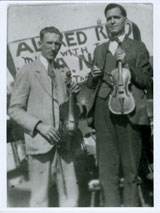Welcome to Native Ground Music, Inc.
For our privacy policy, please visit: https://nativeground.com/privacy-policy
These terms and conditions outline the rules and regulations for the use of Native Ground Music, Inc.’s Website.
Native Ground Music, Inc. is located at:
109 Bell RdAsheville, North Carolina 28805
By accessing this website we assume you accept these terms and conditions in full. Do not continue to use Native Ground Music, Inc’s website if you do not accept all of the terms and conditions stated on this page.
The following terminology applies to these Terms and Conditions, Privacy Statement and Disclaimer Notice and any




 Born in 1924, musician Everett Lilly has been going strong for nearly 85 years, living just a stone’s throw from the Clear Creek property where he was born. A casual observer might not realize that Everett, together with his late brother “B,” traveled the world over, performing and promoting the music of his Raleigh County home.
Born in 1924, musician Everett Lilly has been going strong for nearly 85 years, living just a stone’s throw from the Clear Creek property where he was born. A casual observer might not realize that Everett, together with his late brother “B,” traveled the world over, performing and promoting the music of his Raleigh County home.

